The second match in the quarter-final brought us the clash between what’s arguably the two strongest sides in the FIFA Women’s World Cup 2019. On one side, France have topped their group and remained unbeaten after an extra time win against Brazil. The host were considered as a favourite to lift the trophy and no doubt that they would want to accomplish that with their home fans.
On the other side was the United States, who were also considered as a favourite after their success in the last edition. Similar to France, they finished top of their group with a maximum of nine points. But they were closed to be eliminated by Spain, who eventually fell off the tie through Megan Rapinoe’s penalty. Their match at the spectacular Parc des Princes once again witnessed an outstanding performance from Rapinoe. Two goals in both halves set up a semi-final clash against England for the American girls. Wendie Renard managed to narrow the deficit at the 81st minute, but it was too little, too late for the host.
This tactical analysis will take a look at how Jill Ellis’ side came out with a victory. Meanwhile, using statistics, we will also analyse the tactical errors that cost Corinne Diacre’s side a place in the semi-final.
Lineups
France lined up in a 4-3-3 formation with the veteran keeper Sarah Bouhaddi in goal. Diacre went for her usual back four as Amel Majri and Marion Torrent providing width while Mbock Bathy Nka and Wendie Renard occupied the central spots. Amandine Henry continued to captain the side and she played alongside Elise Bussaglia and Gaetane Thiney in the midfield. Up front, the consistent starters Eugenie Le Sommer and Kadidiatou Diani would provide the goals with Valerie Gauvin.
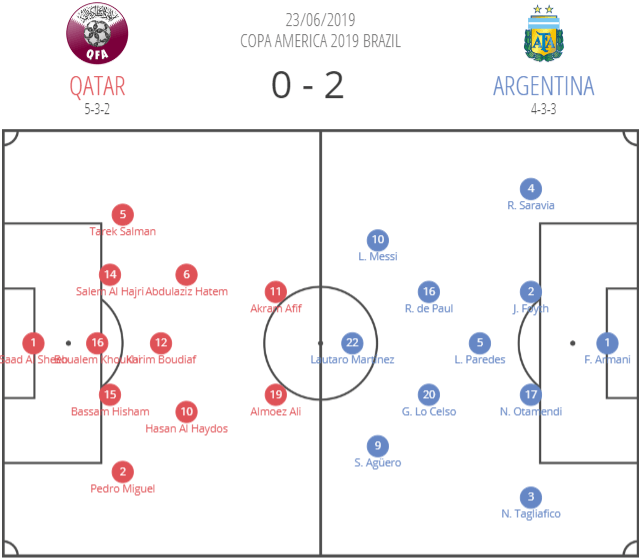
The USA also went for their usual 4-3-3. An unchanged backline starting with Alyssa Naeher in goal, Becky Sauerbrunn and Abby Dahlkemper as centre-backs, Crystal Dunn and Kelley O’Hara occupied the full-back spots. In front of them was Julie Ertz, who would provide a cover for the defenders. Alongside Ertz were midfielders Samantha Mewis and Rose Lavelle playing slightly higher than her. Up front, Carli Lloyd was dropped to the bench, replacing her was Alex Morgan. Playing as wingers were another two key players Megan Rapinoe and Tobin Heath.
United States’ style of play
On the statistical perspective, the USA were not as good as the host. They only registered ten shots towards France’s goal, while Naeher had to face twice as much. Also, Ellis’ side only held 40% of the ball possession and their passing accuracy was 66%. But they had the one factor that helped them qualify for the next round. With eight attempts on target and two of them were converted into goals, they have stunned France while dominated the game.
When on possession, they have the tendency of attacking down both flanks. As both Majri and Torrent usually made overlaps, they created vulnerable spaces inside their own half. This allowed the USA’s wingers to utilise and start a counter-attack.
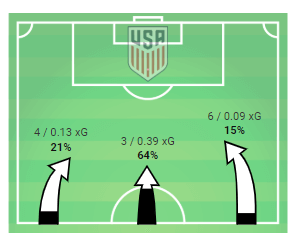
They did this by positioning themselves as wide as possible. It would stretch France’s defensive line and create spaces between the defenders for a through ball. These counter-attacking situations brought the United States great chances throughout the game and it also resulted in Rapinoe’s second goal.
From a combination between Heath and Morgan out on the right-hand side, the right winger made a run into the space between the centre-backs. There, she picked up the pass from Morgan and made a cross into the box. Rapinoe followed that by a shot into the right bottom corner.
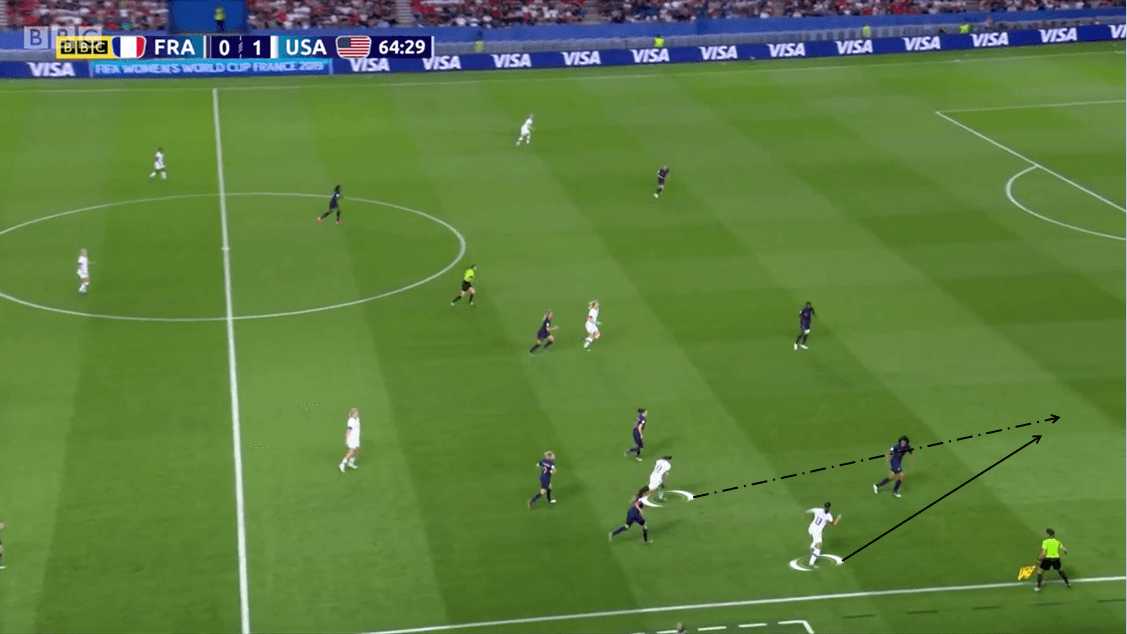
In most of the USA’s attacks, France’s players usually struggled to recover the ball and regain possession. Because of the passing triangles they created and through intelligent movements, it allowed ball circulation to occur more fluently. As shown on the passing map below, the average position of most USA’s players were quite close to each other and they created many passing triangles, mostly on both flanks.
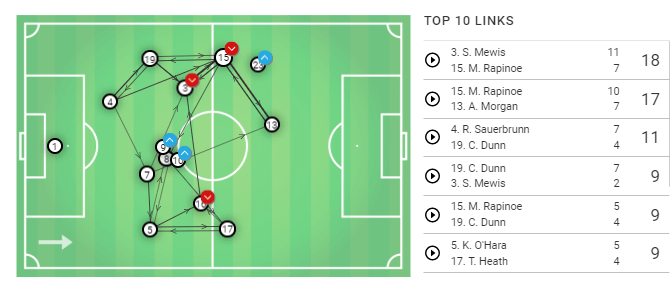
In defend, they formed a 4-1-4-1 defensive structure to deal with France’s attacking threat. Rapinoe and Heath would drop deep and combine with Lavelle and Mewis to form the first defensive line. Their responsibility was to disrupt the opponent’s build-up and regain possession high up the pitch. Julie Ertz played in between the lines and acted as a shield in front of the second defensive line.
Playing with this narrow structure gave them a numerical advantage inside their own half. They would be able to create an overload in a certain area when France circulated the ball into the other side of the pitch.
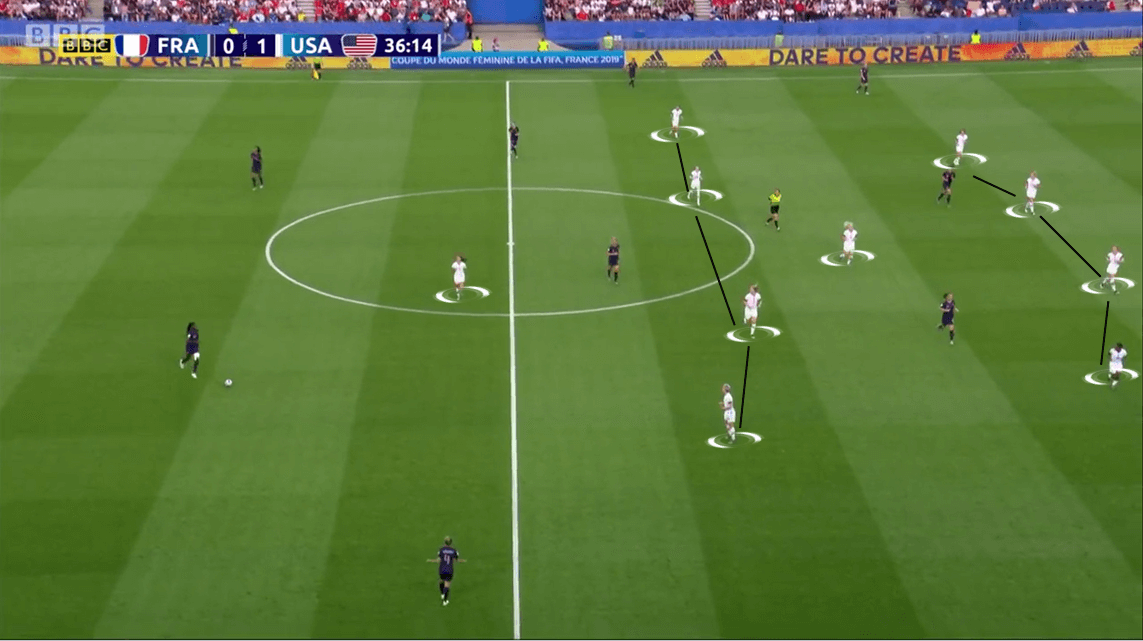
In the second half, Ellis instructed her players to defend in a 5-4-1 structure. Basically, the responsibilities of each player and each line remained the same. But now, Ertz would drop in between Dahlkemper and Sauerbrunn, stretching their defensive line out. This pushed the full-backs into the half-spaces, turned them into the focal point alongside the wingers when the structure shifted from side to side.
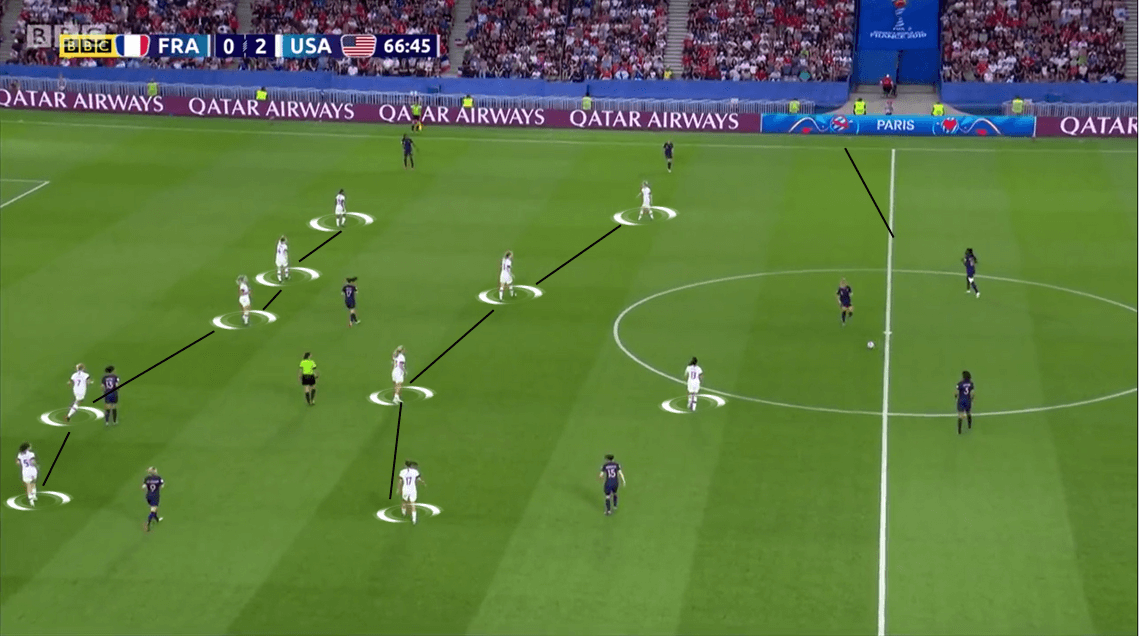
France’s style of play
It was not a good day for the host in terms of attacking. Although they managed to create twenty chances towards Alyssa Naeher’s goal, not much of them caused troubles for the USA’s goalkeeper. There was only one-third of those chances hit the target, which included Renard’s header at the 81st minute.
Also, their expected goals rating (xG) wasn’t very high. Beside Renard’s goal (0,27) and Le Sommer’s chance two minutes earlier (0,18), none of those 23 chances went above 0,15. This showed France were struggled in breaking down the USA’s defence and created chances on goal.

Diacre’s side was also a possession-based side as their ball possession rate stood at 60%. And it is easy to understand why. Based on the passing map below, we can see that they created a formation that is similar to a 4-2-4, with the midfielders acting as the links. It’s worth noticing that the centre-backs usually made passes among them, while also connected the wing-backs into their build-up.
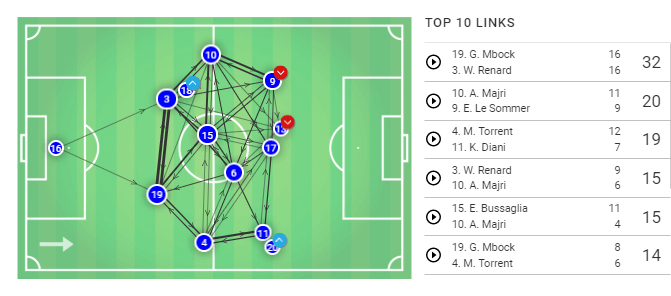
As mentioned, they were struggled in breaking down the USA’s defence. Their defensive structure was quite narrow and usually stuck to the middle of the field. But it also allowed them to utilise their strength, which was their wing-oriented style of play.
They mainly focused their attacks down Majri and Le Sommer’s left-hand side. And it wasn’t a surprise when the left wing-back was the team’s joint-top crosser with Marion Torrent. She had a bit more luck than her opposite teammate as half of her crosses found its target. But unfortunately, none of those efforts were converted into goals.
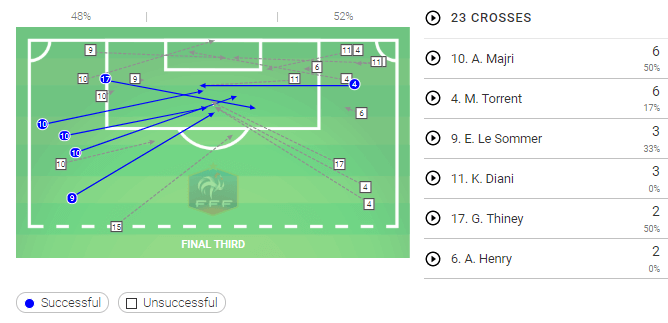
When not on possession, France had to face the pressure came from the USA’s counter-attack. That is why their intention was trying to win the ball high up the pitch using their man-oriented press. The players would overload the wide spaces whenever the opponent’s defenders distributed out to the flanks. Using their man-marking system, they locked up every available passing options that surrounded the ball carrier. This forced her to make a long ball to clear it out, usually, it would be picked up by either Renard and Mbock Bathy.
But, as we have pointed out above, the USA dealt with this by creating passing triangles and intelligent movements from the wingers and the central midfielders. After making a pass, they would run into an available space while still maintained that triangle, or even created a new one. This efficient strategy hampered France’s press from working fluently as it was compared to their earlier matches.
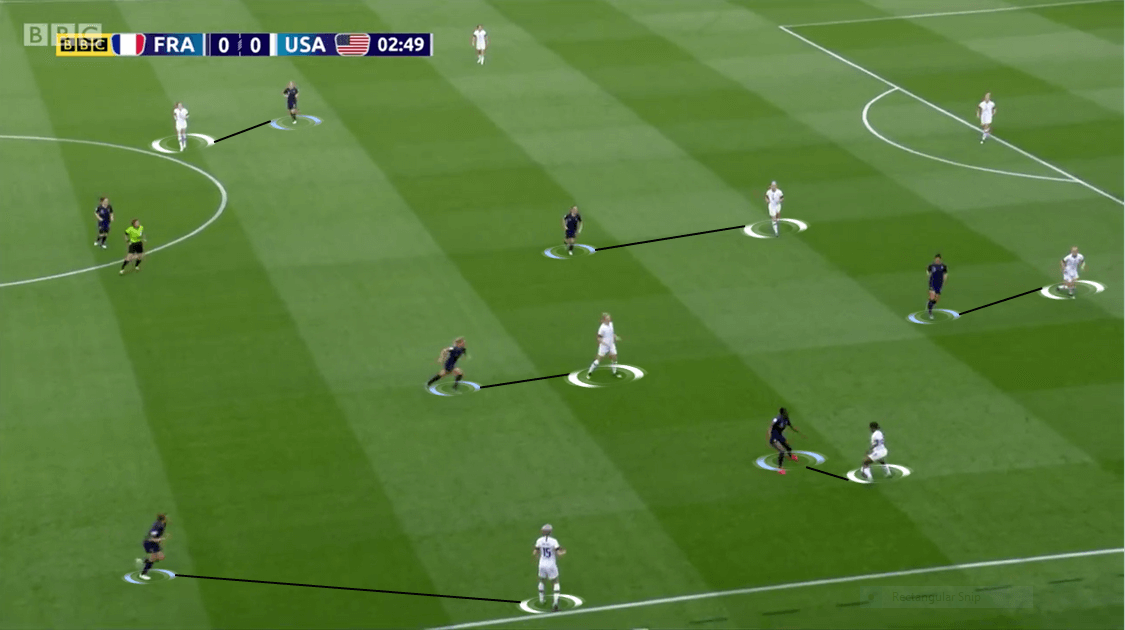
Conclusion
Overall, it was a deserved win for the USA. They have played football in a very catchy and intelligent way and created a lot of troubles for France. While allowing the host dominated the stats, they were lethal in front of goal and stubborn in defence. Although the match was not a goal-thrilling clash like many would have expected, but the beauty of it is uncanny.
France didn’t have their best day at the Parc des Princes. Diacre and her players were outplayed in most of the time and could only found their way back in the game in the last quarter of the game. This golden generation have tried all their best not just in this game, but throughout the entire competition, and they should be proud of their efforts.
If you love tactical analysis, then you’ll love the digital magazines from totalfootballanalysis.com – a guaranteed 100+ pages of pure tactical analysis covering topics from the Premier League, Serie A, La Liga, Bundesliga and many, many more. Buy your copy of the June issue for just ₤4.99 here, or even better sign up for a ₤50 annual membership (12 monthly issues plus the annual review) right here.

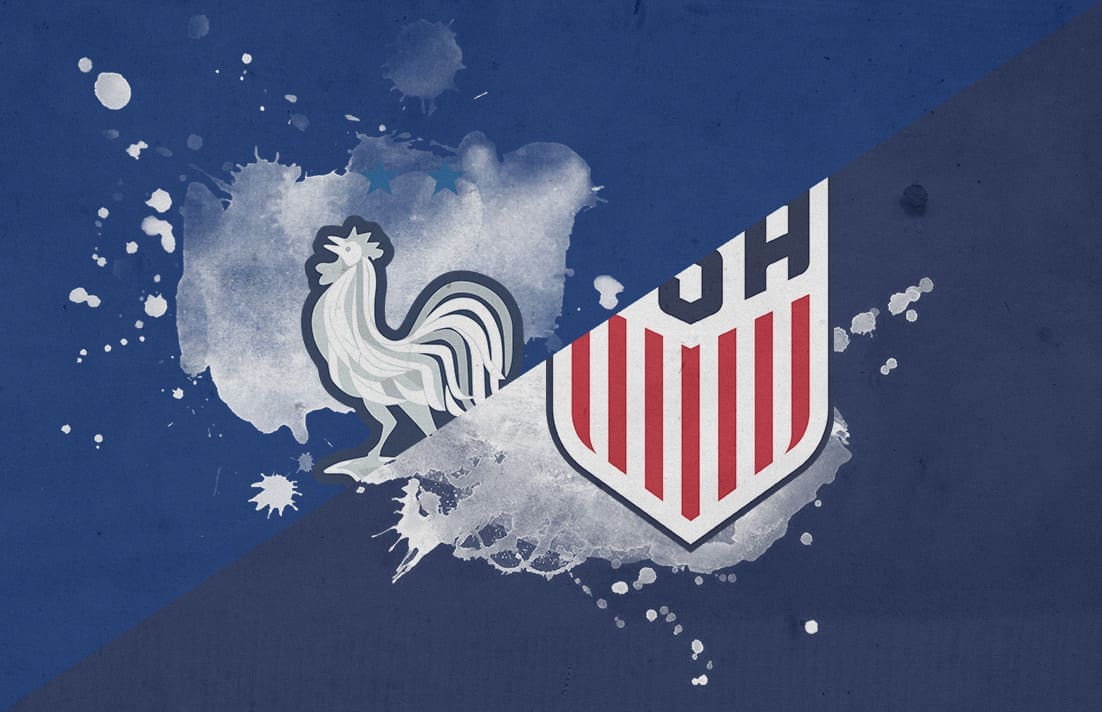



Comments